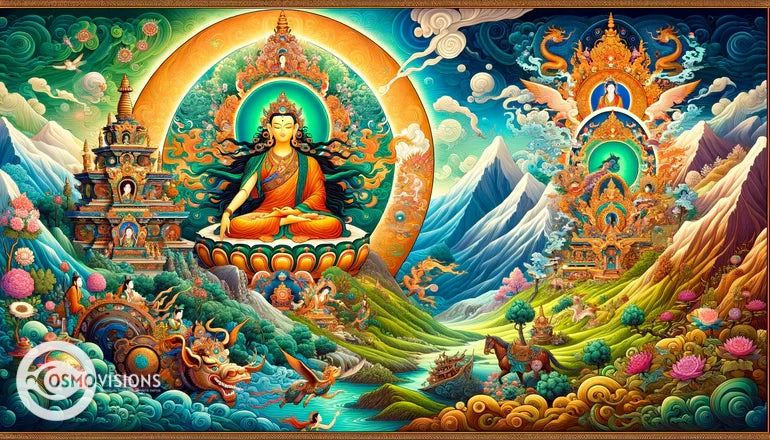Green Tara Mantra meaning
Posted by Massimiliano Geraci

Are you seeking a deeper connection to your spiritual side or looking for peace in this hectic world? The answer might lie in an ancient chant, known as the Green Tara Mantra. With stress and pressures all around, many are turning to time-honored practices for solace and insight.
One fascinating aspect of the Green Tara Mantra is how each syllable is designed to aid us on our journey toward enlightenment. This powerful mantra not only promises protection but also serves as a beacon guiding us on the path of compassion and altruism.
Our blog delves into its profound significance and teaches how these sacred words can bring about transformation in your life.
Discover strength, harmony, and wisdom as we explore this enchanted mantra together—let's unveil the mystery of inner peace.
The Essence of the Green Tara Mantra
Delving into the Green Tara Mantra reveals layers of profound significance, each syllable a vibrant echo resonating with ancient wisdom and compassionate power. It is a spiritual touchstone that embodies the liberating energy of Tara, inviting practitioners to experience her swift assistance in overcoming obstacles and achieving enlightenment.
Understanding the Role of Tara in Buddhism
Tara stands as a powerful figure in Buddhism, embodying limitless compassion and the swift capacity to save beings from suffering. Known as "Dölma" in Tibetan, she represents not only salvation but also the enlightened female principle, which holds significant meaning within the predominantly male pantheon of Buddhist deities.
Her presence is a strong reminder that enlightenment transcends gender and offers an accessible path for all practitioners.
Her role extends beyond mere symbolism; Tara actively reaches out with her strength to assist those on their spiritual journey. Holding an utpala, or blue lotus, she signals her readiness to teach and protect followers through wisdom and loving-kindness.
As a bodhisattva committed to aiding others until every being achieves liberation from samsara—the endless cycle of rebirth—Tara’s ceaseless devotion resonates deeply with believers seeking guidance along the bodhisattva path.
Exploring the Significance of Green Tara
Green Tara emerges as a profound embodiment of active compassion in the Buddhist tradition, extending her promise of salvation to all sentient beings. Revered as "She Who Saves," Green Tara represents more than just an enlightened figure; she stands as a universal symbol of the nurturing and protective qualities often associated with femininity.
Her vibrant emerald hue further signifies vitality and renewal, underscoring her role in quickly coming to the aid of those who invoke her presence.
Delving deeper into Tara's significance reveals layers of spiritual symbolism that resonate across cultures and artistic expressions. Her left hand is poised in the varada mudra—a gesture reinforcing her commitment to liberate followers from suffering and lead them toward enlightenment.
This very gesture resonates within every thangka painting or statue, where devotees find solace and inspiration for their journey toward wisdom and understanding. Through Green Tara's image, individuals around the world connect with age-old narratives that reinforce hope, resilience, and the pursuit of compassionate action amidst life's challenges.
The Rich Symbolism of Tara
Delving into the rich symbolism of Tara opens a window to her profound spiritual significance, where each symbol is imbued with layers of meaning that resonate deeply within Buddhist iconography and practice.
Her vivid representation in thangka art and sacred objects reveals a tapestry woven from mythic imagery and ritual importance, inviting followers to explore the depth of Tara's compassionate presence.
Key Symbols Associated with Tara
Tara, embodying compassion and enlightenment in Buddhism, is often depicted with profound symbols. She holds an utpala or blue lotus in her right hand, a beautiful emblem of purity and resilience that blooms untarnished from murky waters.
This flower represents the teachings of the Buddha and offers protection to those on their spiritual path. In her left hand, she presents the varada mudra—a powerful gesture symbolizing generosity and fulfillment of wishes—as testament to her unwavering commitment to aiding all beings.
Her association with Amoghasiddhi Buddha links Tara to the element Air and endows her with an aura represented by the color green. Each hue of Tara—Green Tara for active compassion, White Tara for healing and longevity, Red Tara for power—brings forth distinct energies designed to support followers on different levels: body, speech, mind, or emotional states.
Symbols such as these are not mere artistic expressions but serve as keys unlocking deeper understanding within Buddhist iconography for practitioners seeking insight into their journey towards wisdom moon and spiritual development.
Tara's Representation in Buddhist Thangka Art
In Thangka art, the compassionate Bodhisattva is often depicted as a radiant figure who embodies both grace and vitality. Her image serves as an inspiration to those seeking spiritual growth and enlightenment.
She sits with one leg extended, ready to rise in response to those in need of her help, which signifies her readiness to spring into action. Her left hand holds the stem of an utpala flower close to her heart, representing purity and power.
She gazes upon all beings with eyes full of love and understanding, inviting them on a path towards liberation from suffering. This iconic representation has become a cornerstone of devotional practice within the Tibetan tradition.
As we delve deeper into the significance behind these sacred images, we next explore "The Origins and History of Tara".
The Origins and History of Tara
Diving into the origins and history of Tara unveils a tapestry woven from ancient Buddhist traditions, where this female Bodhisattva emerges as a compassionate beacon. Her evolution within Buddhism illustrates an intriguing journey, reflecting cultural exchanges and the profound depth of spiritual practice across centuries.
Tracing Tara's Roots in Buddhist Tradition
Tara's history in Buddhism stretches back more than a millennium, deeply woven into the spiritual fabric of the tradition. Origins tell us that she was born from the tears of Avalokiteshvara, the bodhisattva of compassion, highlighting her intrinsic link to benevolent action and mercy.
This poignant birth narrative illustrates her role as a compassionate savior through countless tales and teachings.
In Tibetan accounts, Tara is revered not just as 'Dölma,' but also as an enlightened figure who has transcended gender boundaries to save beings from suffering. Her connection with Amoghasiddhi Buddha reinforces this transcendental nature; together they embody wisdom and active compassion within Vajrayana Buddhism.
Tara symbolizes fertile growth and nurturing qualities in her verdant Pure Land, mirroring ancient 'Green Man' motifs yet presenting these energies through a uniquely feminine lens—a testament to Mahayana Buddhism’s nuanced view on enlightenment beyond gender constraints.
The Power of Chanting the Green Tara Mantra
Chanting the Green Tara Mantra is believed to bring profound spiritual transformation, inviting into one's life the compassionate strength and fearlessness of Tara—discover more about this transformative practice in our exploration.
Benefits for Love, Job, and Wealth
Reciting the Green Tara mantra can have a profound impact on personal relationships. It often helps individuals attract and maintain a loving partnership, fostering harmony and understanding between partners.
This ancient chant is also believed to clear obstacles in one’s career path, opening doors to new opportunities and professional success.
In terms of financial prosperity, practitioners find that regularly engaging with this mantra brings about an increase in wealth. The spiritual vibrations set forth by repeating "Om Tare Tuttare Ture Soha" are thought to magnetize abundance and encourage a flow of material resources toward the chanter.
As both love and livelihood flourish, overall life satisfaction tends to rise among those who commit to this practice.
Tara's Protection from the Eight Fears
Moving from the material gains and emotional comforts that Green Tara's mantra can bring, let us delve into her role as a fierce protector against deeper fears. Tara, in her compassionate might, stands as a bastion of safety for all beings, offering steadfast protection from the eight great fears.
These are not just literal dangers but also represent obstacles we face on our spiritual journey.
Tara's vow to manifest in female form extends far beyond surface-level aid; it encompasses liberation from perils such as ignorance and doubt, as well as external threats like predators or natural disasters.
Holding the utpala flower signifies her commitment to teaching and shielding us from harm. By invoking Tara through her mantra, devotees believe they are shielded by an invisible armor against these profound fears that can hinder both their human experience and spiritual progression.
Variations and Practices
In "Variations and Practices," we delve into the diverse expressions of the Green Tara Mantra, unraveling how different traditions embrace this sacred recitation and guiding you through the steps to integrate it into your own spiritual journey.
Continue reading to explore the manifold paths that lead to Tara's compassionate embrace.
Different Forms of the Tara Mantra
The Green Tara Mantra exists in several variations, each with its unique focus and benefit. Practitioners choose a specific form based on their personal needs or spiritual goals. White Tara mantras, for instance, emphasize longevity and healing, while the Red Tara mantra aligns with love and power.
The versatility of these sacred phrases allows individuals to connect deeply with various aspects of Tara's compassionate energy.
Incorporating different mudras, or hand gestures, enhances the effects of reciting diverse forms of the mantra. Mudras direct the flow of energy through the body and symbolize different teachings within Buddhism.
As you explore how to properly recite the mantra in your practice, consider which gestures resonate most profoundly with your intentions.
How to Properly Recite the Mantra
Moving from exploring the different forms of the Tara Mantra, let's focus on its proper recitation. Start by finding a quiet space where you can sit comfortably without interruptions.
Hold your intention clearly in mind, whether it be for protection, inner peace, or invoking Tara's compassionate strength. Begin chanting "Oṃ Tāre Tuttāre Ture Svāhā" with reverence and concentration.
Pronounce each syllable distinctly and allow the vibration to resonate within you.
As you repeat the mantra, visualize Green Tara before you—a radiant figure embodying fearlessness and tender caring. With each chant, imagine her blessings flowing through you, empowering your body, speech, and mind.
Continue this practice regularly; early morning or evening hours can enhance the spiritual experience. Allow this sacred mantra to become a part of your daily routine for personal transformation and spiritual growth.
Setting Up a Shrine for Tara Practice
Creating a shrine for Tara practice serves as a sacred space where daily rituals and meditations can take place. Choose a quiet, clean area in your home dedicated solely to this purpose.
Place an image or statue of Tara at the center, ensuring it is raised above the ground level out of respect. Surround her representation with offerings such as fresh flowers, incense, candles, or water bowls – these are traditional ways to honor and please deities like Tara.
Make sure to include elements that symbolize key aspects of her teachings: perhaps texts related to dharma or items representing the Three Jewels – Buddha, Dharma, Sangha. Perform prostrations before your shrine as a gesture of humility and devotion; they help embody reverence for Tara's guidance on overcoming spiritual dangers represented by the Eight Great Terrors.
Regular engagement with your shrine keeps you connected with Tara’s energy and fosters an environment conducive for deepening meditation practices and developing bodhichitta – the mind striving towards awakening for the benefit of all beings.
Tara's Influence and Miraculous Stories
Throughout history, the Green Tara has been revered for her compassionate presence, with countless anecdotes highlighting her intervention during moments of crisis. These tales not only reflect deep personal transformations but also showcase the widespread reverence for Tara's benevolence across various cultures and traditions.
Accounts of Tara's Help Among Followers
Followers of Tara often share powerful stories about how the bodhisattva goddess has impacted their lives. Many believers recount instances where chanting the Green Tara Mantra manifested protection and assistance in times of need.
These personal testimonies highlight a deep spiritual connection between the deity and her devotees.
In one remarkable instance, an English national found themselves facing severe legal consequences after attempting to smuggle a sacred Tara image out of Nepal. This story serves as a testament to the profound respect and value attributed to representations of Tara within Buddhist communities.
Such incidents reinforce the belief that Tara's image holds not only artistic but also immense spiritual significance, offering guardianship against adversity for those who honor her presence.
Special Times and Places for Tara Practices
Tara practices hold particular power when performed at dawn or dusk, times traditionally seen as thresholds between day and night. These moments are believed to be potent for spiritual activities because they symbolize the transition from darkness to light, reflecting Tara's role in overcoming fear and guiding devotees towards enlightenment.
Practitioners often gather during these twilight hours in sacred spaces filled with representations of Tara, such as shrines adorned with thangkas and statues bathed in the soft glow of butter lamps.
Certain locations are also considered especially auspicious for honoring Tara. High-altitude monasteries set amidst the mountains of Tibet, where the air is thin and clear, provide natural sanctuaries that resonate with her energy.
Lush gardens mirror her Pure Land, inviting a sense of peace conducive to meditation on her qualities. Whether nestled in remote valleys or situated within bustling cities, these places create a sanctuary for practitioners to chant mantras and seek Tara's blessings for protection against spiritual dangers and guidance along their path toward inner awakening.














